Who Doesn’t Love a Massage? Bet Your Horse Would Too..
CH Staff.
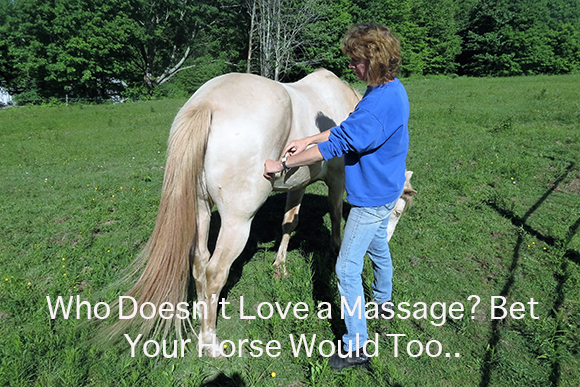
Massage is defined as, “The rubbing and kneading of muscles and joints of the body with the hands, especially to relieve tension or pain.” Many of us have enjoyed these benefits. Professional athletes in all sports know that sports massage is an extremely important adjunct to health. Why is it any different for our equine athlete? Well. It isn’t.
There are many schools of massage therapy for horses. Many organizations have developed and you can choose where to go to become certified and/or licensed as either a human massage therapist and/or an equine massage therapist.
Obviously many of the basic principles of massage are the same. The differences are obviously in the nature of the musculature and skeleton of the beast!
Catskill Horse sat down with Equissage certified equine massage therapist Penny King. 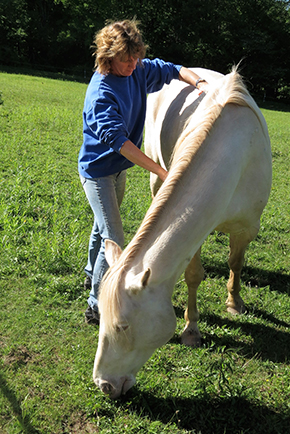 Penny started in the human field of massage therapy and has now added the qualification in equine therapy.
Penny started in the human field of massage therapy and has now added the qualification in equine therapy.
CH: What made you decide to take up equine massage after years as a regular masseuse?
PK: I have always loved horses and have ridden since I was a kid. They are my passion. After 17 years of helping clients through my Hands On Therapeutic Massage business, I am fulfilling a desire to help the equine athlete as well.
CH: Can you explain a little bit about why you chose Equissage as a training method?
PK: I chose to get my certification at Equissage School of Massage Therapy in Round Hill, Va., instructed by Mary Schreiber, the founder of Equissage in 1989. Her hands on approach, knowledge, and years of experience convinced me that Equine Sports Massage Therapy is exactly what I want to do.
CH: How long do you train to become an equine massage therapist?
PK: The school consisted of a 50 hour week, split between morning hours in the 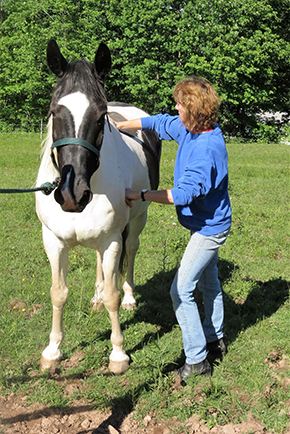 classroom and afternoon hours in the barn. Only four or five students are enrolled in a session, allowing each of us quality one-on-one time and our own horse to work with. At the end of the week we were given a written test and then after lunch, a one hour massage with the horse of our choice. Upon “passing” we then received our certificates.
classroom and afternoon hours in the barn. Only four or five students are enrolled in a session, allowing each of us quality one-on-one time and our own horse to work with. At the end of the week we were given a written test and then after lunch, a one hour massage with the horse of our choice. Upon “passing” we then received our certificates.
CH: How does it compare to training to work as a masseuse on people?
PK: I quickly learned that the skeletal muscle anatomy of a horse is very similar to that of a human. Having worked on humans for 17 years has made it easier to observe and treat problem areas on the horse. Just like people who have different jobs, horses have different “occupations” as well.
A horse’s body is made up of 60% muscle. A performance horse involved in jumping, dressage, cutting, or reining will repeatedly use certain muscles that an average trail horse may not over use, however, muscles and tendons become tight, strained, knotted and painful.
Massage relieves tension in the muscle, creating better range of motion, reduces 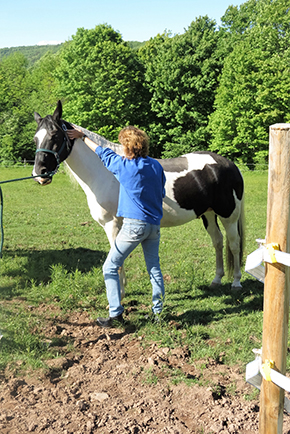 inflammation, increases circulation, and increases flow of synovial fluid to the joints. Massaging maintains the entire body in better physical condition and aides in prevention of injury.
inflammation, increases circulation, and increases flow of synovial fluid to the joints. Massaging maintains the entire body in better physical condition and aides in prevention of injury.
A typical session lasts an hour, or longer, starting from the poll area, down the neck, shoulder, withers and forearm. Working over the back, rib cage, hind-quarters and tailhead, down the stifle and hocks and back leg.
I work both sides, locating any tension, knots, or tight muscle areas and if I find any, I use different techniques to aid in helping any problem areas.
Some horses will flinch or pin their ears. This tells me where and how to affectively apply massage techniques. Most horses enjoy the treatment and perform better afterwards.
Massage is most effective as a preventative measure before being worked and post an event.
CH: How can clients (horse owners not the horses!) best prepare for your visit?
PK: An owner should be present and have their horse brushed and fairly clean of wet or dry mud.
CH: How many sessions does it take to truly benefit the horse and/or how often should a horse receive a massage and is it possible to injure a horse if massage is not completed correctly?
PK: Massage cannot do harm and only aid in better overall performance and health of the 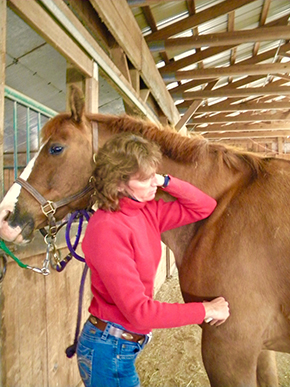 horse. It should be a part of every horse owners maintenance program, like
horse. It should be a part of every horse owners maintenance program, like
teeth with a dentist, feet with a farrier and deworming.
CH: How do you handle a difficult or resistant horse?
PK: There are situations where a horse seems difficult or reluctant to massage. When pain or soreness is involved, a horse cannot tell me. His reaction to the treatment on a soar muscle may be ears pinned back, twitching, moving away from me or even kicking at me. His response tells me to change my treatment on that area.
There is, on occasion, a horse that simply doesn't like to be touched or massaged. In that case, I choose to do neither. There is no reason to force an issue when it is only upsetting the horse. However, an alternative that seems to calm the horse is Reiki. This is still bringing healing energy to the equine without applying pressure and works very well.
CH: What types of issues do you most commonly see?
PK: I tend to see a lot of tender backs, muscle knots in the neck and sore hindquarters. These are all muscle areas that are being used daily and overused depending on the horse’s job. A barrel racing horse uses his body so differently than a dressage horse. The dressage horse tends to have very tight neck muscles and the barrel horse has tight hindquarters. A trail horse typically has a more sensitive back and wither area.
Regardless of its discipline, any equine will benefit from massage, whether before, during or after a workout. Maintenance is the key to better performance and a happier horse.
CH: Do you give the owners exercises they can on their horse on a daily basis between your visits?
PK: I am happy to instruct owners on simple massage techniques they can perform themselves.
CH: Do you offer discounts for more than one horse at the same location and how much should someone expect to pay for the equine massage service? What geographic area do you cover?
PK: A one hour session costs $65.00 and I do offer group discounts.
I also offer 30 minute demos for a group and travel to Delaware and Otsego Counties.
CH: What is the best method for people to reach you to learn more?
PK: You can reach me at 607-746-6286
A Happy Horse makes a Happy Rider!


